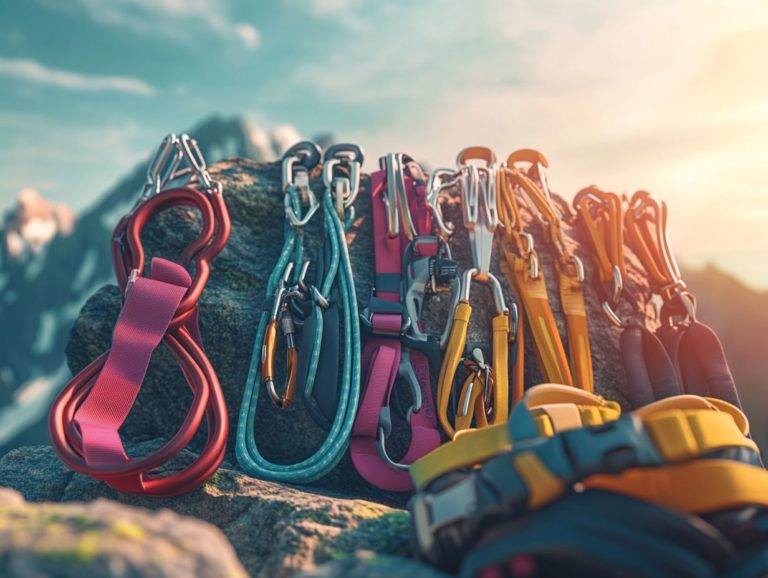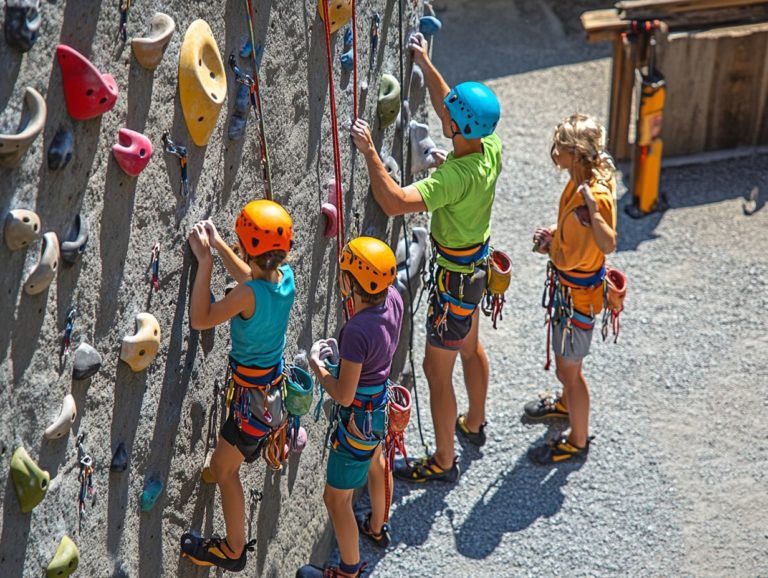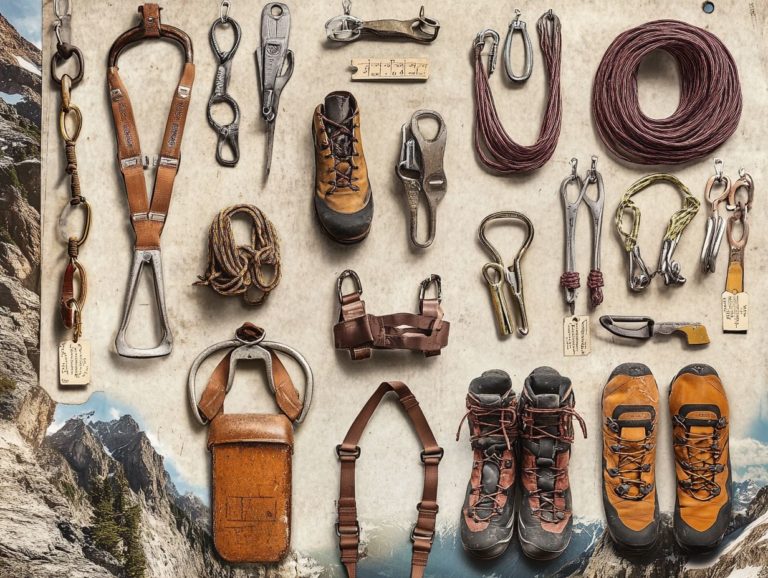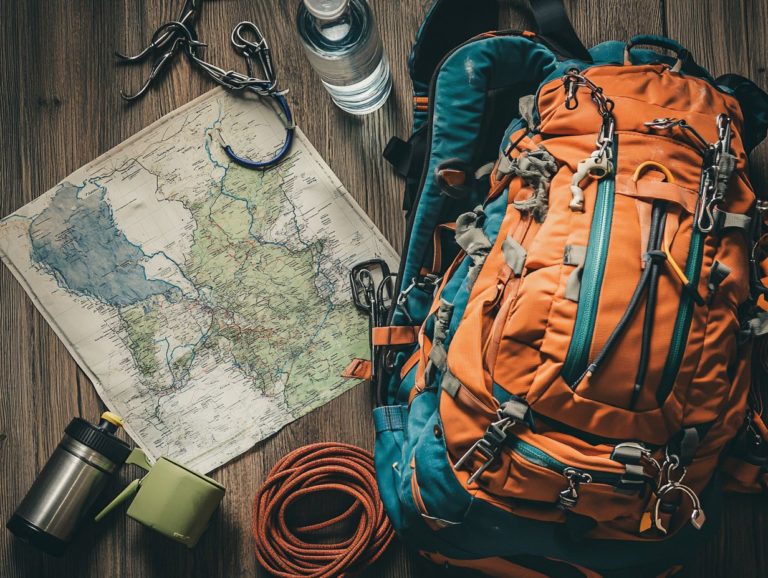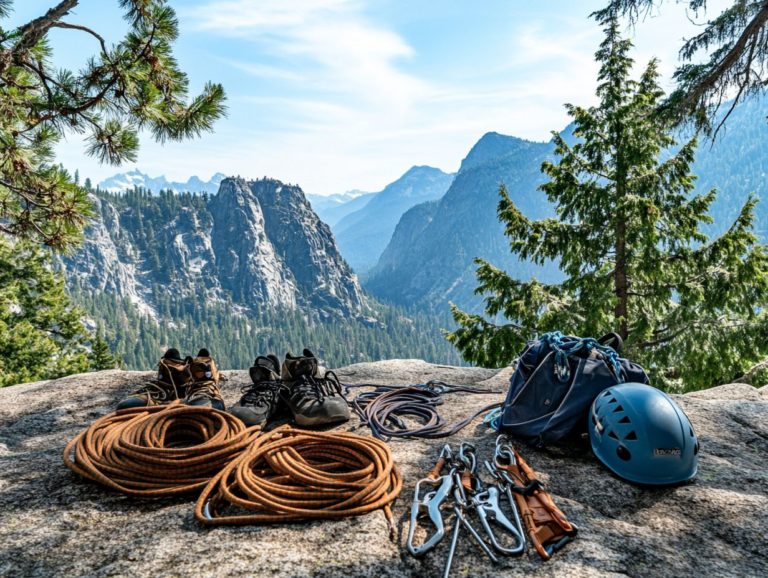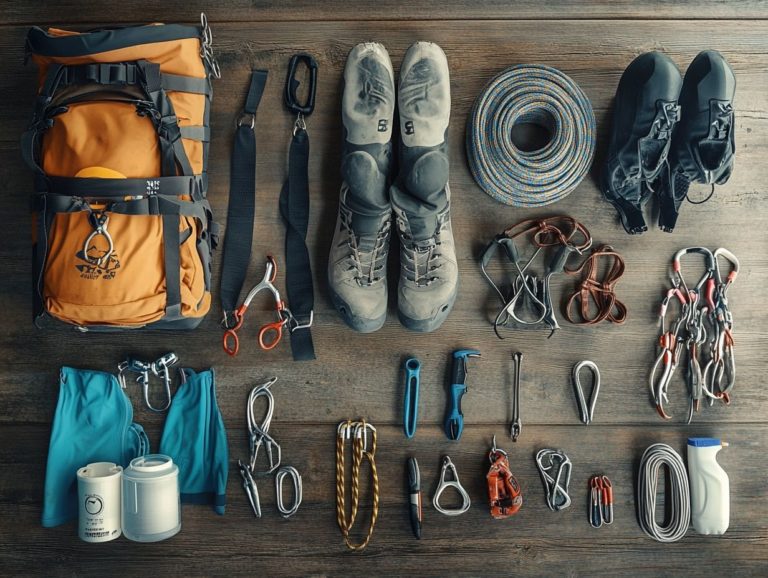The Best Climbing Gear for Urban Climbing
Urban climbing offers an exhilarating opportunity to discover the heights of your city, but having the right gear is essential for both safety and performance.
Whether you’re a seasoned climber or just starting your journey, understand what equipment to invest in to improve your climbing experience.
From finding the ideal pair of climbing shoes to acquiring essential safety gear, this guide outlines the must-have items every urban climber should consider.
Gear up now and conquer your urban playground!
Contents
Key Takeaways:
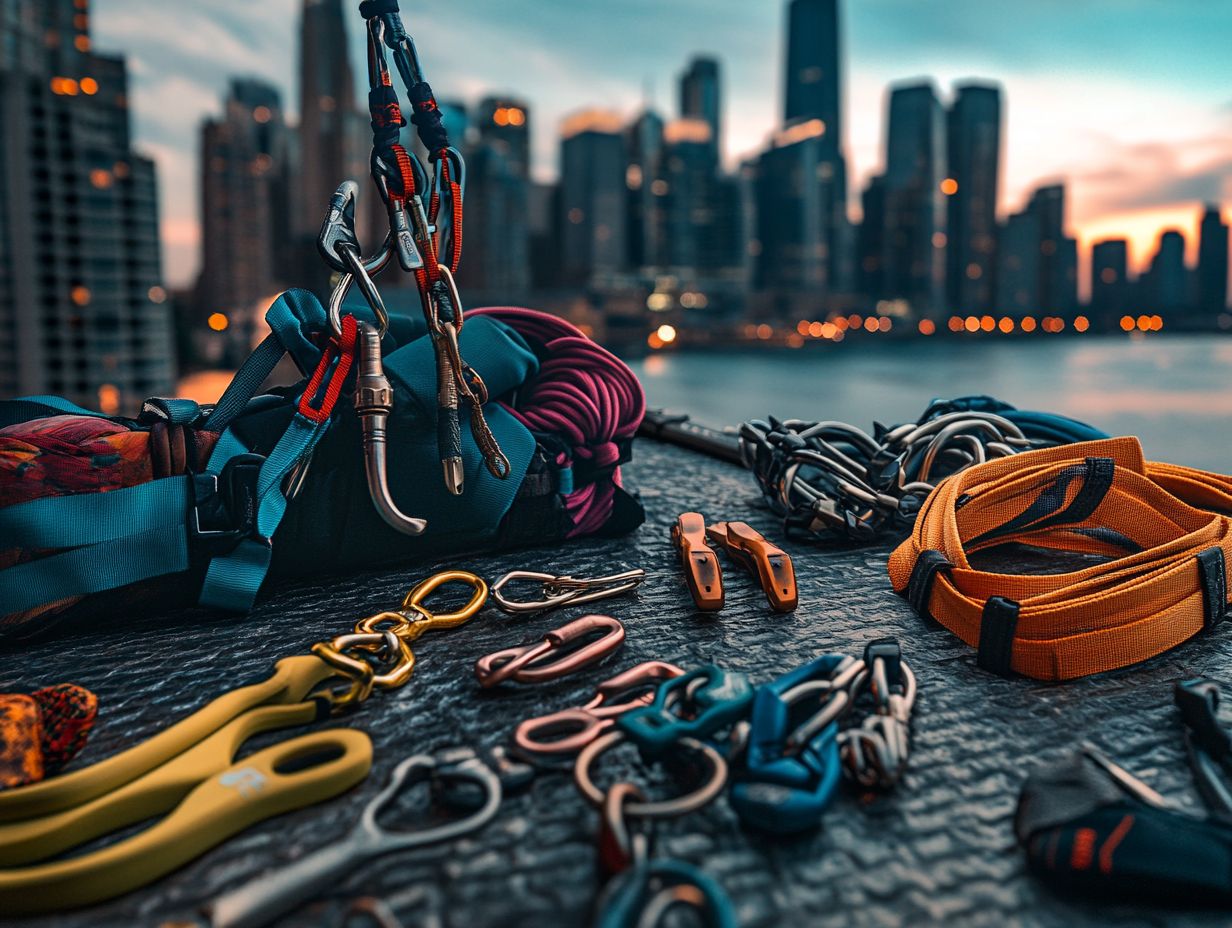
- Invest in a pair of high-quality climbing shoes for urban climbing. Look for sticky rubber soles, a comfortable fit, and durable construction.
- Always carry a chalk bag to keep your hands dry and improve grip on urban climbing routes. Consider using liquid chalk for indoor climbing to minimize mess.
- A climbing harness is essential for safety during urban climbing. Choose one that fits comfortably, has adjustable leg loops, and is suitable for lead or top rope climbing.
1. Climbing Shoes
Climbing shoes are a fundamental part of your climbing gear, essential for improving your performance and technique. They provide the support, grip, and sensitivity needed for both indoor and outdoor adventures.
Choosing the right climbing shoes can significantly impact your safety, so it s crucial to understand the various features and types available.
The fit of your climbing shoes is arguably the most vital aspect, allowing for precise foot placement an essential element in techniques like smearing (using the rubber on your shoe s sole to stick to the wall instead of a foothold) or edging. Materials also play a significant role: synthetic blends typically stretch less, offering a snug fit, while leather molds to your foot over time for added comfort.
For sport climbing, high-performance models like the La Sportiva Theory deliver exceptional toe stiffness. For bouldering, you might prefer softer options like the Scarpa Drago, which maximize sensitivity for dynamic moves. By exploring various styles and brands, you can discover the top climbing gear for rock climbers that provide the perfect balance between comfort and capability tailored to your climbing discipline.
2. Chalk Bag
A chalk bag is an essential accessory for climbers, designed to keep your hands dry and enhance your grip on climbing holds crucial for your safety and performance.
Selecting the right one can greatly impact your climbing experience. You ll encounter various types of chalk, including:
- Loose chalk
- Chalk balls
- Liquid chalk
Each option has its advantages. For example, loose chalk allows for quick application but can be messy, while chalk balls provide more controlled distribution perfect for those who prefer precision. Keeping your hands dry is essential; moisture can lead to slippage and unexpected falls.
When shopping for a chalk bag, consider factors like size, closure mechanisms, and how it aligns with your climbing style. Compact and accessible bags are typically favored for outdoor climbs, while larger ones might serve you better in indoor gyms.
To maximize your chalk use, apply it sparingly yet consistently, ensuring your hands remain dry during critical moments on the wall.
3. Climbing Harness
A climbing harness is an essential piece of safety gear that connects you to the climbing rope, offering security and support while still allowing for freedom of movement. Whether you re just starting out or are a seasoned climber, it s essential.
With so many options available, choosing the right climbing harness can profoundly affect your overall experience. You have:
- Full-body harnesses for extra safety
- Sport climbing harnesses tailored for quick ascents and agility
- Trad harnesses, which offer versatility for various climbing styles
Comfort is equally important; features like gear loops, padding, and adjustable leg loops can enhance both fit and functionality. By familiarizing yourself with the different features of each type, you can make informed choices that boost your safety and enhance your climbing performance.
Explore your climbing gear options today and share your urban climbing adventures with us!
4. Belay Device
Belay devices are essential tools for your climbing safety. They enable you to control the rope effectively during your ascent and ensure your partner’s security. Popular options include the ATC and Grigri. Each device has unique benefits that cater to different climbing styles.
These devices typically rely on a friction-based system to manage your descent. They work to arrest falls and provide a secure grip during various maneuvers. Understanding their role is vital, not only in fall prevention but also in maintaining your psychological comfort while climbing.
When selecting the ideal device, consider factors like rope diameter, the terrain you ll be tackling, and your personal preferences. The ATC is celebrated for its simplicity and versatility, making it a great choice for traditional climbing and multi-pitch routes. The Grigri excels in sport climbing scenarios, thanks to its assisted braking feature that simplifies handling.
By assessing the advantages of each model, you can choose a device that aligns with your specific needs. This maximizes both safety and performance in various climbing situations, especially when you consider the most versatile climbing gear for any trip.
5. Carabiners
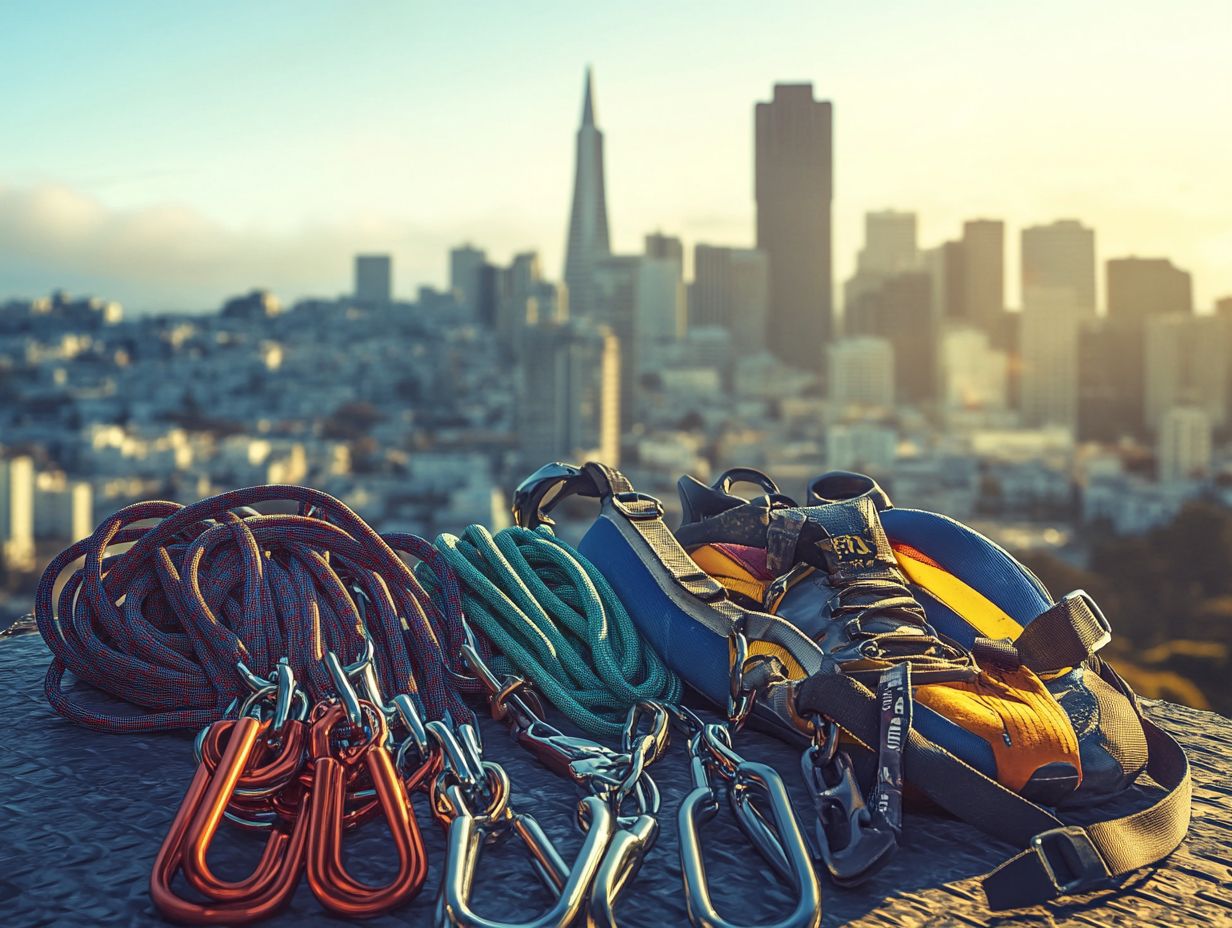
Carabiners are incredibly versatile pieces of climbing gear that play a crucial role in your climbing safety. They securely connect various pieces of equipment and come in a range of shapes and locking mechanisms to suit different climbing scenarios.
Locking carabiners provide an added layer of security with their twist-lock or auto-lock features, making them particularly valuable in high-risk environments. In contrast, non-locking carabiners are easier to clip and unclip and are better suited for lighter situations, such as setting up quickdraws.
Understanding these differences is key when selecting the right type of carabiner for your specific needs, whether you’re rappelling, belaying, or setting up a top-rope system. Don’t forget: regular maintenance through periodic inspections for wear and tear can extend their lifespan and ensure your safety during climbs.
6. Climbing Rope
The climbing rope is your lifeline and a pivotal element of safety. It secures you during both ascents and unexpected falls. There are various types of ropes tailored to different climbing styles, whether you re into sport climbing or trad climbing.
Dynamic ropes stretch under load, effectively absorbing the shock from falls. This reduces the force on you and your protection points. Static ropes, on the other hand, offer minimal stretch, making them ideal for stability during rappelling or hauling gear.
Choosing the right rope enhances your performance and plays a significant role in your overall safety. Regular inspections and proper care, such as washing and drying techniques, are essential to maintain the integrity of these crucial tools. This way, you can focus on your ascent with the confidence that comes from knowing you re well-protected.
7. Crash Pad
A crash pad is a must-have for your outdoor climbing adventures, especially in bouldering. It s designed to cushion falls and protect you from injury, significantly enhancing your overall climbing experience.
By absorbing the impact of a fall, a crash pad drastically reduces the risk of serious harm, making it a critical addition to your gear. You ll find a variety of options available, from lightweight and portable pads perfect for short trips to larger, more robust versions that provide superior cushioning for higher falls.
When choosing the right crash pad, consider your climbing style whether you lean towards highball routes or prefer tackling more technical low problems. Also, take the terrain into account, as some pads perform better on uneven surfaces. Effective positioning can also enhance your safety; strategically placing pads at angles based on anticipated fall zones can further minimize injury risks.
8. Climbing Helmet
A climbing helmet is an essential piece of safety gear that protects your head from falls, debris, and various hazards. It ensures a safer outdoor climbing experience.
These helmets come in various styles, from hard-shell designs that provide excellent impact protection to lightweight models that emphasize comfort during long ascents.
Key features to consider include ventilation systems, adjustable straps, and compatibility with headlamps, all of which enhance your climbing experience.
Whether you’re tackling rocky terrain or scaling indoor walls, wearing a helmet is crucial; it significantly reduces the risk of injury. For a proper fit, adjust the harness so it sits snugly yet comfortably on your head. Additionally, having the best climbing gear for women climbers is essential for safety and performance. Don’t forget routine maintenance, like checking for cracks or wear, is vital for optimal safety.
9. Quickdraws
Quickdraws are connectors that help keep you safe while climbing. They link your climbing rope to bolts or anchors, providing a secure and efficient means of protection during your ascents.
These versatile tools enhance both your safety and efficiency while navigating climbing challenges. You ll find several types of quickdraws, including sport, trad, and alpine, each designed for different climbing styles and environments.
When selecting the right quickdraw, consider the weight of the gear, the type of rock you’re scaling, and the potential risks of falls. Opt for a durable design with a reliable locking mechanism to ensure your safety. Additionally, understanding the essential gear for indoor climbing can help you choose equipment that best suits your needs. This way, your quickdraws can handle the rigors of climbing, allowing you to focus on your ascent with confidence.
10. Climbing Pants
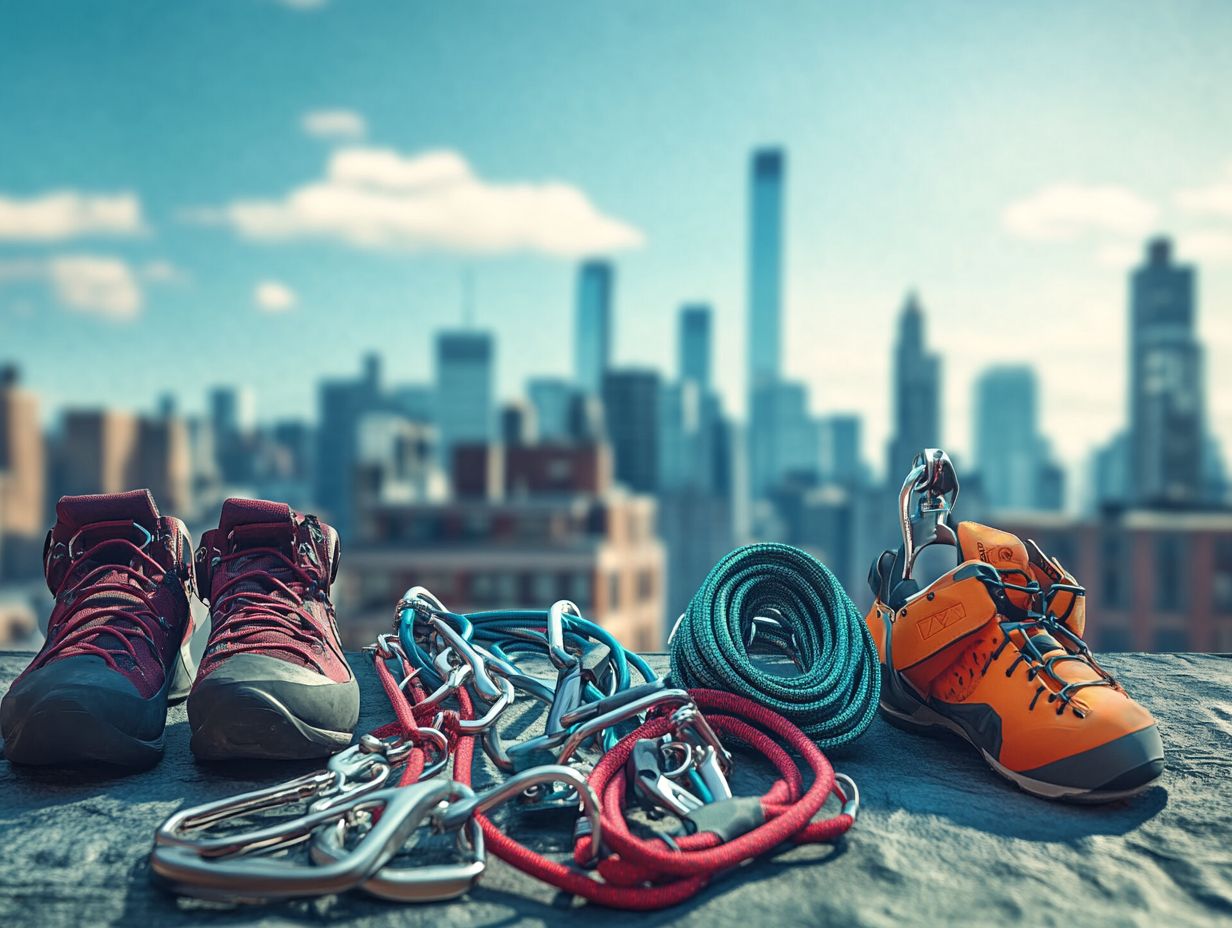
Climbing pants are specially designed to boost your climbing adventure! They offer a perfect blend of comfort, mobility, and protection against the elements.
These specialized pants typically feature durable, breathable materials like nylon or elastane blends. They allow for flexibility and a full range of motion while withstanding the wear and tear of rugged surfaces.
The fit is essential; they should be snug enough to prevent snagging yet loose enough for unrestricted movement.
You might lean towards styles that use eco-friendly materials, a growing trend in outdoor gear focused on sustainability. Brands like Prana and Patagonia are leaders in this area, committed to using recycled materials without compromising performance. For those interested in climbing, it’s also worth exploring the most reliable climbing gear brands, including newer names like Black Diamond, which offer innovative designs for technical climbing.
11. Climbing Shirt
A climbing shirt is a must-have in your climbing gear! It s designed for comfort, breathability, and mobility, helping you perform your best during climbs in various conditions.
The materials in these shirts usually include fabrics that pull sweat away, such as polyester or nylon. They keep you dry by drawing moisture away from your skin. Many designs incorporate technical blends that provide stretchability, allowing you the freedom of movement needed for challenging routes.
Never underestimate the importance of fit; a well-fitted climbing shirt enhances maneuverability. Looser options can provide that extra airflow you crave.
Brands like Patagonia, Arc’teryx, and Black Diamond are known for their innovative styles that seamlessly blend functionality with aesthetics, catering to diverse climbing environments and personal preferences.
12. Climbing Gloves
Climbing gloves are an essential part of your climbing safety gear. They protect your hands from abrasions and improve your grip on holds, which is crucial for your performance and safety.
Not all climbing gloves are the same; their design often caters to specific climbing styles. For example, bouldering gloves are typically thinner, prioritizing sensitivity over protection. In contrast, sport climbing gloves offer more cushioning for longer routes, while alpine climbing gloves are sturdier to withstand colder temperatures and harsh conditions. If you’re interested in understanding more about what to consider, check out what is the best gear for solo climbers.
When choosing a pair, consider your climbing style and the level of dexterity the ability to move your fingers easily and warmth you need. A proper fit and durable materials can greatly enhance your performance, allowing you to focus on what truly matters: reaching new heights. Don’t forget to check out the top 10 must-have climbing gear accessories for your next adventure.
13. Climbing Backpack
A climbing backpack is a vital piece of gear that you ll depend on to carry your must-have equipment safely and comfortably. It ensures you re well-prepared for your outdoor climbing adventures.
These backpacks come in various sizes, allowing you to choose one that suits your trip’s length and your gear. Multiple compartments are essential for organized equipment think harnesses, ropes, and quick draws making access easy during climbs.
Comfort is crucial; padded shoulder straps and adjustable waist belts provide the support needed for lengthy hikes to climbing sites. With proper organization, you can speed up gear retrieval and enhance your safety by minimizing the risk of forgetting important items. For your outdoor adventures, consider the best outdoor clothing for urban exploration. This way, you can focus entirely on the challenge ahead.
14. Climbing Tape
Climbing tape is a simple yet essential accessory that serves multiple purposes in your climbing adventures. It protects your hands and fingers and secures your gear. It s a must-have in any climber’s toolkit.
This versatile tape acts as a protective barrier against cuts and abrasions while enhancing your grip, especially during challenging routes. It s invaluable for quick repairs on essential equipment like slings or harnesses, significantly boosting your safety during ascents.
To apply climbing tape effectively, clean and dry the area you plan to wrap. Then, snugly but not too tightly secure it around your fingers or gear. Assess your climbing environment; don’t hesitate to use the tape more liberally when facing rough surfaces or embarking on prolonged climbs. For the best results, consider investing in the most durable climbing gear of 2024. This way, your hands stay protected and your equipment secure.
15. Climbing Guidebook
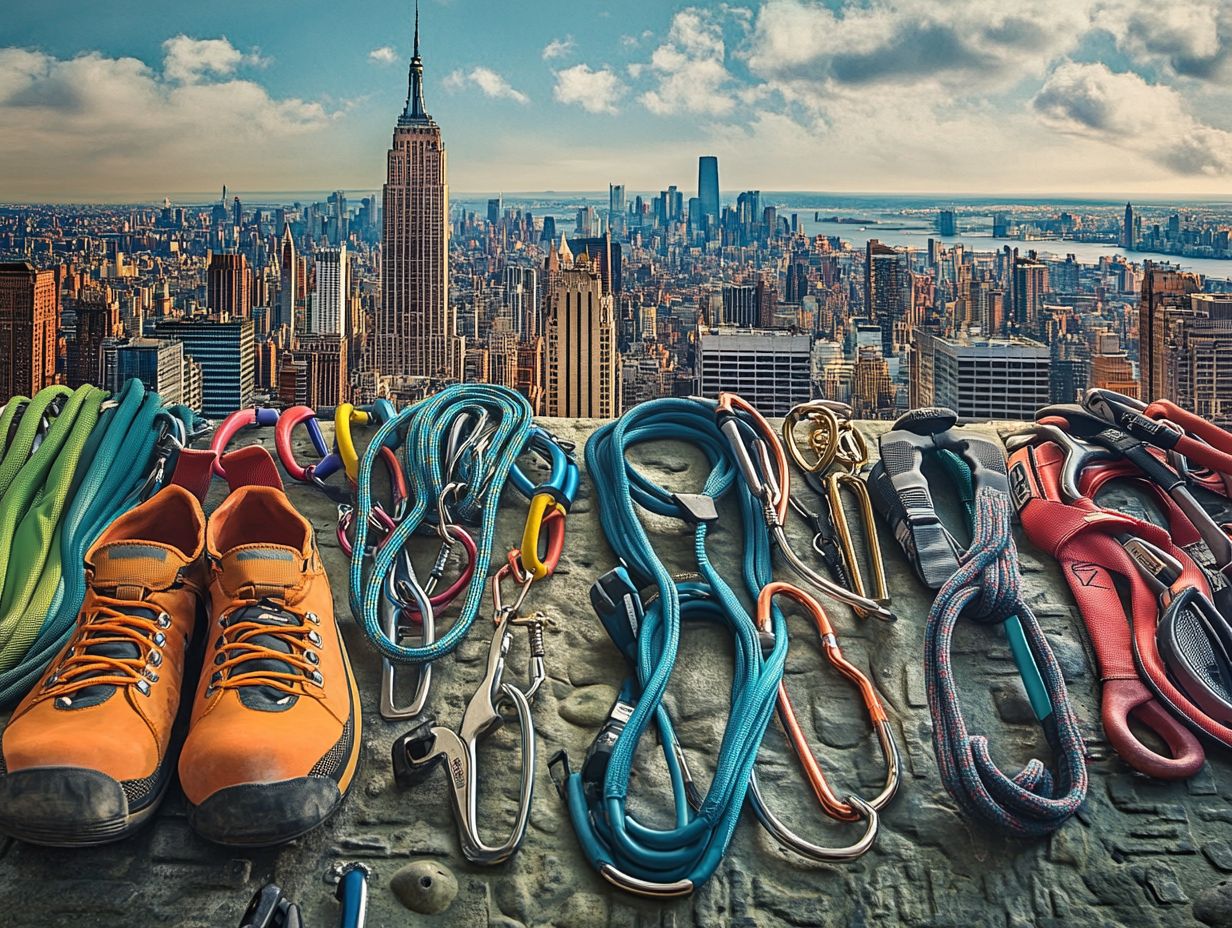
A climbing guidebook is an essential resource for climbers, providing valuable insights into routes, techniques, and safety tips for both indoor and outdoor adventures. It s crucial for boosting your climbing skills!
These comprehensive guides typically include detailed route descriptions outlining difficulty levels, technical challenges, and the approximate time needed for each climb. They feature a grading system, a way to measure how difficult a climb is, allowing you to assess your current skill level and select routes that will safely push your boundaries.
Beyond physical challenges, you’ll also learn about local etiquette, such as respecting wildlife and fellow climbers. This fosters a sense of community and environmental stewardship. By using these resources, you refine your technical abilities and deepen your understanding of climbing culture, leading to more rewarding experiences in the sport.
Frequently Asked Questions
What is urban climbing?
Urban climbing lets you scale buildings and bridges in cities!
What type of gear is needed for urban climbing?
The best climbing gear for urban climbing includes a harness, climbing shoes, chalk, carabiners, a belay device, and a helmet.
Ready to elevate your climbing game? Make sure you have the right gear for your next adventure!
Do I need special gear for urban climbing?
Some gear can be helpful, like grip gloves and a rope bag. You can also use traditional rock climbing gear.
What makes a harness suitable for urban climbing?
A good harness should fit comfortably and be lightweight. It should also have enough gear loops for all your equipment.
Are there any specific features to look for in climbing shoes for urban climbing?
Choose climbing shoes with a sticky rubber sole for grip on smooth surfaces. A low profile and snug fit help with precision footwork.
Is a helmet necessary for urban climbing?
Absolutely! A helmet is essential for protecting your head from falling debris and potential falls.

